深度學習中的數據增強技術(二)
阿新 • • 發佈:2019-02-21
data ont return per 分享圖片 slice google ordering res
上篇文章介紹了深度學習中數據增強技術的應用,及部分TensorFlow實現代碼。廢話不說了,這篇接著介紹:
TensorFlow實現圖片數據增強
註:類似的方法放在了代碼中註釋的部分,實際調試時可以分別打開運行
③圖像色彩調整
import matplotlib.pyplot as plt import tensorflow as tf # 讀取圖片 image_data = tf.gfile.FastGFile("data/dog3.jpg", ‘br‘).read() # 4中調整圖片大小的方法,實際應用中可以根據需求組合調整 with tf.Session() as sess: img_data= tf.image.decode_jpeg(image_data) plt.imshow(img_data.eval()) plt.show() # 將圖片數據轉換成實數類型 img_data = tf.image.convert_image_dtype(img_data, dtype=tf.float32) # 亮度 # adjusted = tf.image.adjust_brightness(img_data,0.5) # adjusted = tf.clip_by_value(adjusted, 0.0, 1.0) # adjusted = tf.image.adjust_brightness(img_data, -0.5)# adjusted = tf.clip_by_value(adjusted, 0.0, 1.0) # adjusted = tf.image.random_brightness(img_data,0.5) # 對比度 # adjusted = tf.image.adjust_contrast(img_data,0.5) # adjusted = tf.image.adjust_contrast(img_data, 5) # adjusted = tf.image.random_contrast(img_data,0.1,5) # 色相 # adjusted = tf.image.adjust_hue(img_data,0.3)# adjusted = tf.image.adjust_hue(img_data, 0.1) # adjusted = tf.image.adjust_hue(img_data, 0.9) # adjusted = tf.image.adjust_hue(img_data, 0.6) # adjusted = tf.image.random_hue(img_data,0.5) # 飽和度 adjusted = tf.image.adjust_saturation(img_data,-5) # adjusted = tf.image.adjust_saturation(img_data, 5) # adjusted = tf.image.random_saturation(img_data,2,5) # 圖像標準化 均值為0 方差變為1 # adjusted = tf.image.per_image_standardization(img_data) plt.imshow(adjusted.eval()) plt.show()
圖片效果
原圖:
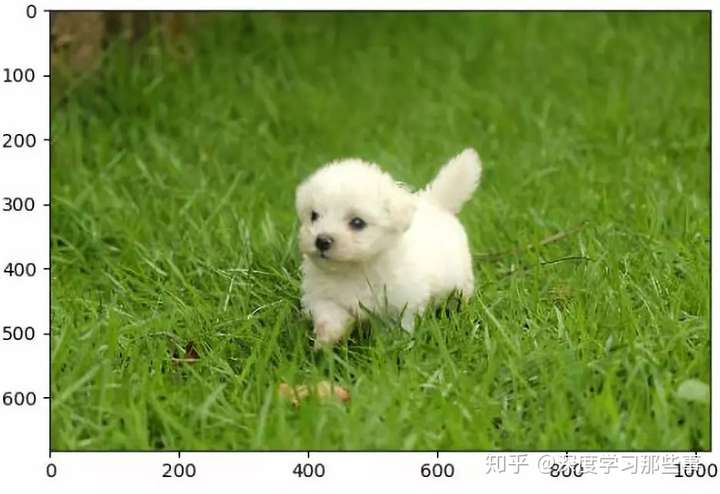
處理後:
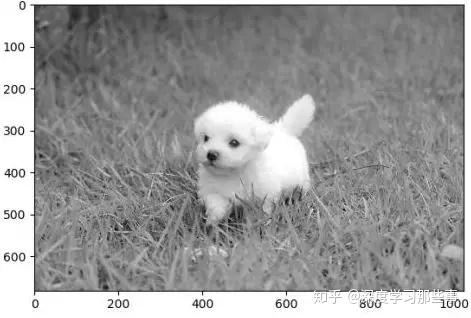
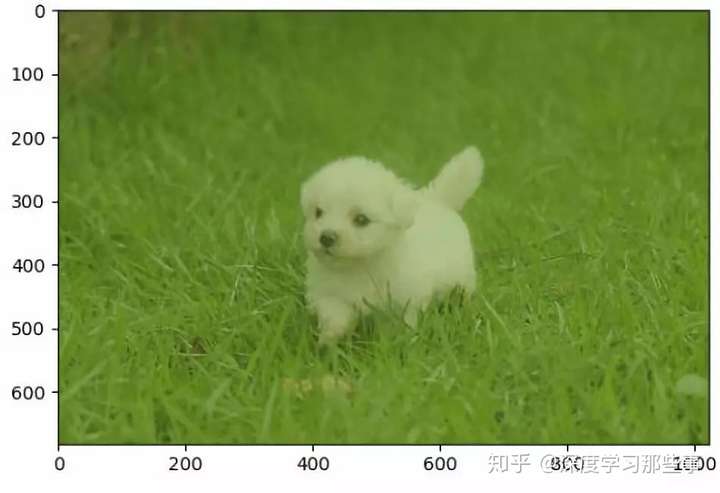
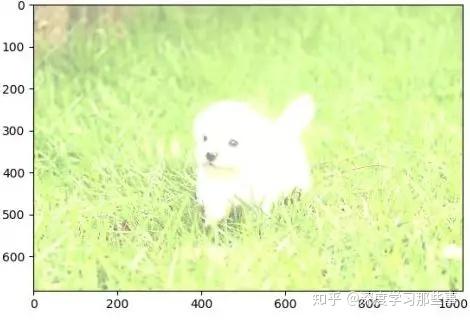
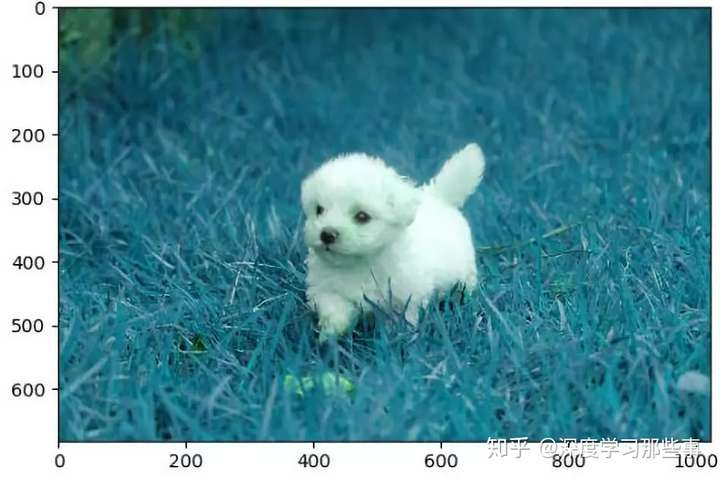
④標註、裁剪
import matplotlib.pyplot as plt import tensorflow as tf # 讀取圖片 image_data = tf.gfile.FastGFile("data/dog3.jpg", ‘br‘).read() # with tf.Session() as sess: img_data = tf.image.decode_jpeg(image_data) plt.imshow(img_data.eval()) plt.show() # 將圖片數據轉換成實數類型 img_data = tf.image.convert_image_dtype(img_data, dtype=tf.float32) # 將圖片縮小一些,這樣可視化能讓標註框更加清楚 img_data = tf.image.resize_images(img_data,[180,267],method=1) batched = tf.expand_dims(tf.image.convert_image_dtype(img_data,tf.float32),0) boxes = tf.constant([[[0.05,0.05,0.9,0.7],[0.28,0.36,0.62,0.56]]]) result = tf.image.draw_bounding_boxes(batched,boxes=boxes) plt.imshow(result[0].eval()) plt.show() # print(result) # 隨機截取圖片 begin,size,bbox_for_draw =tf.image.sample_distorted_bounding_box(tf.shape(img_data),bounding_boxes=boxes,min_object_covered=0.4) batched = tf.expand_dims(tf.image.convert_image_dtype(img_data,tf.float32),0) image_with_box = tf.image.draw_bounding_boxes(batched,bbox_for_draw) distored_image = tf.slice(img_data,begin,size=size) plt.imshow(distored_image.eval()) plt.show()
圖片效果
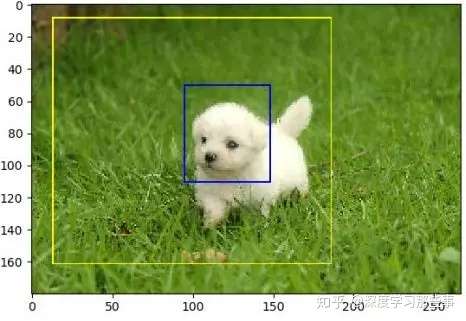
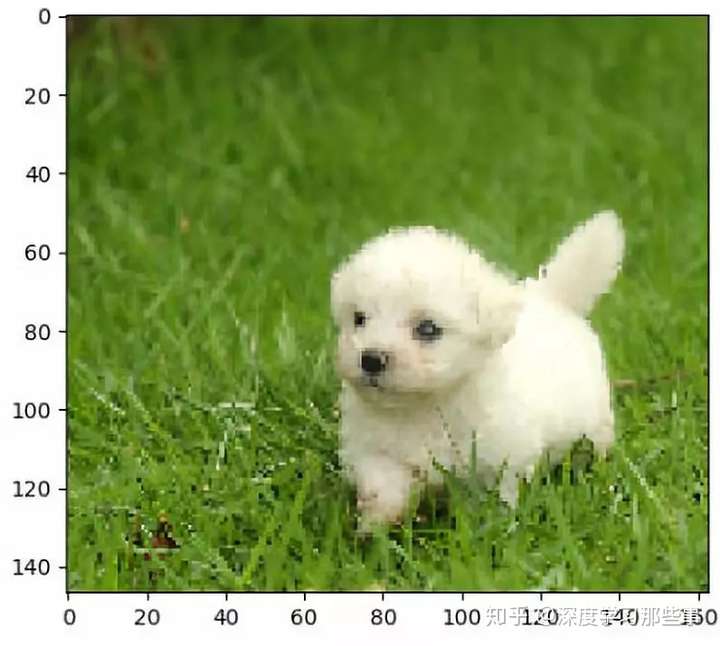
關註公眾號“從機器學習到深度學習那些事”獲取更多最新資料
代碼整合總結
import tensorflow as tf import numpy as np import matplotlib.pyplot as plt ‘‘‘ 給定一張圖片,隨機調整圖像的色彩。因為調整亮度、對比度、飽和度和色相的順序會影響最後得到的結果,所以可以定義多種不同的順序。 具體使用哪一種順序可以在訓練數據預處理時隨機的選擇一種。這樣可以進一步降低無關因素對模型的影響 ‘‘‘ def distort_color(image, color_ordering=0): if color_ordering == 0: image = tf.image.random_brightness(image, max_delta=32. / 255) image = tf.image.random_saturation(image, lower=0.5, upper=1.5) image = tf.image.random_hue(image, max_delta=0.2) image = tf.image.random_contrast(image, lower=0.5, upper=1.5) elif color_ordering == 1: image = tf.image.random_saturation(image, lower=0.5, upper=1.5) image = tf.image.random_brightness(image, max_delta=32. / 255) image = tf.image.random_contrast(image, lower=0.5, upper=1.5) image = tf.image.random_hue(image, max_delta=0.2) elif color_ordering == 2: image = tf.image.random_saturation(image, lower=0.5, upper=1.5) image = tf.image.random_contrast(image, lower=0.5, upper=1.5) image = tf.image.random_hue(image, max_delta=0.2) image = tf.image.random_brightness(image, max_delta=32. / 255) # 還可以添加其他的排列 else: image = tf.image.random_contrast(image, lower=0.5, upper=1.5) image = tf.image.random_brightness(image, max_delta=32. / 255) image = tf.image.random_hue(image, max_delta=0.2) image = tf.image.random_saturation(image, lower=0.5, upper=1.5) return tf.clip_by_value(image, 0.0, 1.0) def preprocess_for_train(image, height, width, bbox): # 如果沒有提供標準框,則認為整個圖像就是需要關註的部分 if bbox is None: bbox = tf.constant([0.0, 0.0, 1.0, 1.0], dtype=tf.float32, shape=[1, 1, 4]) # 轉換圖像張量的類型: if image.dtype != tf.float32: image = tf.image.convert_image_dtype(image, dtype=tf.float32) # 隨機截取圖像,減少需要關註的物體大小對圖像識別算法的影響 # 為圖像生成一個隨機distorted的邊框,Generate a single randomly distorted bounding box for an image bbox_begin, bbox_size, _ = tf.image.sample_distorted_bounding_box(tf.shape(image), bounding_boxes=bbox,min_object_covered=0.4) distorted_image = tf.slice(image, bbox_begin, bbox_size) # 將隨機截取的圖像調整為神經網絡輸入層的大小。大小調整的算法是隨機選擇的。 distorted_image = tf.image.resize_images(distorted_image, [height, width], method=np.random.randint(4)) # 隨機左右翻轉圖像 distorted_image = tf.image.random_flip_left_right(distorted_image) # 使用一種隨機的順序處理圖像的色彩 distorted_image = distort_color(distorted_image, np.random.randint(2)) return distorted_image image_raw_data = tf.gfile.FastGFile("./data/dog1.jpg", ‘br‘).read() with tf.Session() as sess: image_data = tf.image.decode_jpeg(image_raw_data) bboxes = tf.constant([[[0.05, 0.05, 0.9, 0.7], [0.35, 0.47, 0.5, 0.56]]]) # 運行6次獲得6中不同的圖片,展示出來 for i in range(6): result = preprocess_for_train(image_data, 299, 299, bboxes) plt.imshow(result.eval()) plt.show()
參考資料
21個項目玩轉深度學習
TensorFlow實戰Google深度學習框架

深度學習中的數據增強技術(二)
